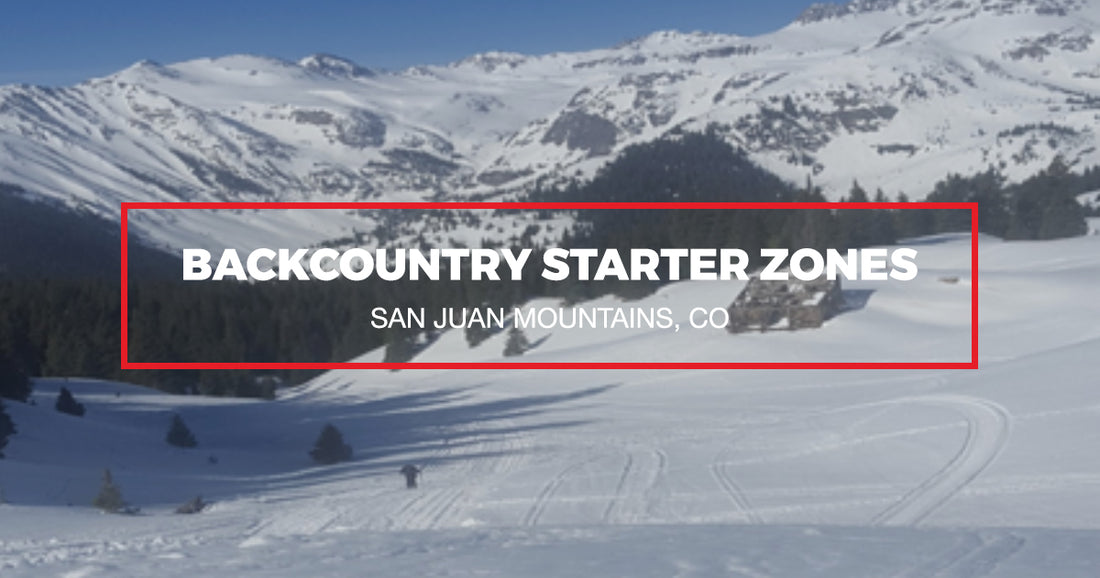Safety
This is part of a series from Weston. Its intention is to be inclusive to all and be respectful of the communities in which we live and the mountains we ride. As users of the backcountry, we strive to be ambassadors of the backcountry. In making these backcountry starter zones available to all, we hope to share and teach these zones respectfully so that future generations will have these areas to cherish, protect and share their passion to the generation that follows. With that being said, one should never venture into these zones without a beacon, probe, shovel and the knowledge to use them and travel safely in backcountry terrain through an AIARE 1 course. Additionally, this blog only names the zones and provides a general description, it is up to you to safely plan your routes and get the full research done.
Additional Recommended Resources
Backcountry Starter Zones in the Northern San Juan Mountains
By Anton Kress
So, you want to get into the backcountry in the San Juan Mountains and all you’ve heard is how gnarly and huge everything is. You see your friends at the bar after a day of riding Telluride resort and your buddies roll in, rowdy, smelly, covered in snow with smiles beaming from ear to ear. You fall into the classic resort town trap of feeling like you missed out on an amazing time. You want to keep up with the homies, but you’ve never splitboarded, and you’ve never ridden in the backcountry. So, after taking an Avy 1 course in Silverton, buying your beacon, 3-meter probe and durable shovel (not plastic) you feel ready to take the plunge. Weston splitboard in had you are raring to go. But where do you go?
Lizard Head Pass
One of the first places to go is Lizard Head Pass. Lizard Head separates the town of Rico from Telluride. Merely a 15-minute drive from Rico, it takes about 30 minutes from Telluride. Just above Trout Lake, Lizard Head Pass offers 360 degrees of amazing views. On the east side of the highway, you’ll find Sheep Mountain. While Sheep Mountain provides some Big Mountain Lines, the meadows below offer an excellent opportunity to try out your new gear while not exposing yourself to avalanche terrain. Parking at Cross Mountain Trailhead, walk across the road to the trail and make your way up into the meadows just above the highway. You’ll find terrain that isn’t exactly exciting, but it's perfect to spend your first day out in the backcountry trying out your new gear. You’ll be able to tour around in the snow, practice transitioning and you’ll be able to put a few turns in as well.
Returning to the car, you’ll be face to face with Lizard Head Rock looming over you. Before you are a series of meadows offering varying degrees of pitches. BEWARE! South of the trailhead, the terrain gets steeper and terrain traps are abundant. However, if you pick your terrain wisely, you can take your first backcountry laps without exhausting yourself. This is a great place to practice transitions and really learn what your gear is capable of. As you progress into bigger terrain, don’t be surprised when you come back to Lizard Head in search of some classic lines.
Woods Lake
Woods Lake is worth a mention here. Taking the Fall Creek exit on Highway 145 signs will direct you all the way up to Woods Lake. The road is generally plowed only so far, so when the snow gets too deep, park the car and put your skins on. Tour the road all the way up to the lake and even into the woods around the lake. Your photos will be the envy of friends and you can make your way back down the road to your car.
Red Mountain Pass
I could write a book about Red Mountain Pass and not even scratch the surface. That being said, I know people who have forgotten more about Red Mountain Pass than I might ever know. What you should know is that Red Mountain Pass is serious business. Once you leave the town of Ouray you begin to ascent The Million Dollar Highway. Considered the most treacherous, dangerous, scary, gnarly, you name it highway in the lower 48, you’ll be forced to pay attention to the road, while your friends alternate from sheer terror to excitement over the terrain possibilities. However, let’s not get ahead of ourselves. Get to the top of the pass and park in the obvious parking lot on the east side of the highway. This is actually the turn in to Red Mountain Rd. As you begin your tour up the road you are immediately face-to-face with:
McMillan Peak
Commodore Basin and Trico Peak
Conclusion
I hope you enjoy any time you spend in the San Juan Mountains. The San Juan Mountains are my home and its where I make my life. If you choose to come here, remember that the San Juan’s are hard to earn and can easily humble you. Prepare yourself by educating yourself as much as you possibly can. Come prepared for every mission you make into the mountains but also arm yourself with a dose of humility and reality. Don’t push yourself trying to keep up with the Jones’ (pun intended?). Don’t let this get you down. You can always have a blast in this unique range and every day offers new opportunities. Go at a pace that you are comfortable with. I hope to see you on the skin track!
Join the Community
We've been working hard to develop a community of likeminded backcountry individuals who want to share their passion and experiences in the backcountry with others. Come join the Weston Backcountry Community Facebook group and get involved!


1 comment
Thank you